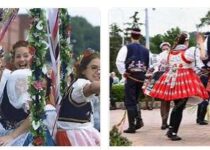Iceland in the 1970’s
The island has gradually seen its residents grow (216,628 in 1974; density 2 residents per km 2), given the rather high coefficient of increase (13 ‰ per year). The tendency to live in cities is increasingly pronounced (urban index: 86%), while the colonization centers in the interior are in decline. In 1974, beyond the capital (Reykjavik: 84,772 residents), They exceeded 10,000 residents Kópavogur (11.463) and Hafnarfjördur (10.926), which can be considered its gemmations, and Akureyri (11.484), commercial, industrial and administrative center of the Iceland northern.
Volcanism has given rise to impressive manifestations. On November 14, 1963, a new island (Surtsey) arose on the southern coasts and the eruption continued until May 1965, with the formation of a volcano, called Surtur. In 1970 the Hekla volcano awakened. But considerable damage caused above all the eruption of Heimaey on the largest island of the Vestmannaeyjar group, which, which began on 23 January 1973, lasted for 5 months and heavily damaged the city of Vestmannaeyjar (4906 residents), Destroying the third part. of the inhabited area and forcing the other residents to temporarily abandon their homes.
The economy has not undergone significant changes. While the crops are limited to a thousand hectares (destined for potatoes), to which numerous greenhouses must be added that use the thermal waters for heating, sheep (846,000 heads) and cattle (67,000) and therefore the production of milk and butter. An aluminum factory works in Straumsvik. For now, the tourist movement is modest (71,676 visitors in 1975). Fishing continues to be the main resource; it increased from 734,000 t (1970) to 994,791 (1975) (mainly cod and herring), and at the same time the resulting industries (oil and fishmeal) progressed. On the other hand, whaling is on the decline (365 units in 1973-74). The area reserved for fishing, which since 10 September 1958 had been extended to 12 miles, it was brought to 50 miles from February 1972, not without arousing protests from foreign fishermen (especially British). The commercial fleet now has 154,381 tons of tonnage, to which 996 units (for 167,000 tons) dedicated to fishing must be added. The trade balance is passive, influenced by the increased cost of fuel oil, necessary for fishing boats, while water from hot springs, as well as water energy, are increasingly used to heat homes. Following an agreement signed on September 26, 1974, the United States retains the Keflavik base. 000 t) devoted to fishing. The trade balance is passive, influenced by the increased cost of fuel oil, necessary for fishing boats, while water from hot springs, as well as water energy, are increasingly used to heat homes. Following an agreement signed on September 26, 1974, the United States retains the Keflavik base. 000 t) devoted to fishing. The trade balance is passive, influenced by the increased cost of fuel oil, necessary for fishing boats, while water from hot springs, as well as water energy, are increasingly used to heat homes. Following an agreement signed on September 26, 1974, the United States retains the Keflavik base.
Politics
The policy of the Iceland of the sixties and seventies is dominated by the dispute over fishing rights, reopened with the second enlargement of territorial waters (from 4 to 12 miles), established unilaterally in 1958. The policy of subsequent extensions of territorial waters aims to protect, even at the cost of repeated economic and diplomatic conflicts with Great Britain (accidents on the high seas after 1958 and in the winter of 1972-73), Icelandic fishing from the competition of the most modern British and German fleets, to safeguard what still remains the basis of exports (90%) and of the entire Icelandic economy. The initiative of 1958 had been taken by the Jónasson government, formed by the Progressive (agrarian) and Social Democratic parties and by the People’s Alliance (formed in 1956 by the Communist Party with the aggregation of dissident Social Democrats), already hostile to the maintenance of the NATO base in Keflavik: the consensus of public opinion was very wide, the Alliance was pressing (which would not regret the negative repercussions on relations with NATO), while the opposition (the independentists), a staunch supporter of NATO, limited her criticisms to forms of government action. In 1961 Great Britain and the FRG accepted the 12 miles. government action. In 1961 Great Britain and the FRG accepted the 12 miles. government action. In 1961 Great Britain and the FRG accepted the 12 miles.
The 1971 elections marked the fall of the coalition between Social Democrats and pro-independence (conservatives), which had ruled Iceland since 1959, with the leaders Thors and Benediktsson, and the advent of the Johanesson cabinet, made up of progressives, the People’s Alliance and the Union of Liberals and Leftists (formed in 1970 by the trade unionist Valdimarsson with the communists who disagreed on the Soviet occupation of Czechoslovakia). In the question of staying in NATO, controversial in the coalition, the line that intended to substantially change the Icelandic position prevailed, without leaving the alliance, but by imposing the revision of the 1951 treaty and the gradual eviction of Keflavik; a step in this direction was taken in 1973 at NATO. The new Icelandic government, even more sensitive to isolationist currents and the weight of the Communists, was able to leverage the strategic importance of Keflavik for the North Atlantic route. when he opened a new phase of the dispute over fishing rights, bringing fishing frontiers to 50 miles in 1972 and establishing a 100-mile anti-pollution zone (measures that affected the FRG as well as Great Britain). The Icelandic uncompromising attitude (in May 1973 the breakdown of the Anglo-Icelandic negotiations took place after the accidents on the high seas of the winter) was maintained towards both the two allied powers, the EEC and the International Court of The Hague. (1972-73). On 12 October 1974 an interim agreement was concluded with Great Britain. The official proclamation by the new Hallgrimsson ministry of an economic maritime border of 200 miles, already ventilated since the constitution of the cabinet (August 1974), is now awaited.
The whole Icelandic foreign policy is tinged with isolationism, not only towards NATO (to which it substantially contributes only with the Keflavik base, lacking armed forces), but also in the framework of Nordic cooperation (see Sweden), in which it clearly participates posting. After joining the EFTA late (in 1970) the Iceland it concluded in July 1972 a free trade agreement with the EEC (however, opposed by the Communist party). In August 1976, Geir Hallgrimsson was re-elected president of the Republic.
Literature
For a long time, even for a large part of our century, Icelandic culture and intellectual life remained stuck in their great past. Insularity, not to mention the isolation of national life, is documented here by extreme linguistic conservatism. Until the total political independence from Denmark (June 17, 1944), Icelandic literature today has retained the archaic linguistic and thematic imprint of its medieval classicism, despite the obvious phonetic and neologistic innovations.
When in 1930 H. Laxness’s Kvaedhakver (“Notebook of poetry”) marked the triumph of free verse and, shortly after, Th. Thórdharson’s panegyric of the Soviet Union (Raudhahaetten, “The Red Danger”, 1935) opened the as a result of new political experiences, even the most recent European cultural ferments began to penetrate and permeate the substantially peasant society of the island.
The younger generation of writers – here also, roughly speaking, split between pro-Western and pro-Communist – today faces fervent ideological debates in the press, in periodicals (very notable Birtingur, 1953 ff.) And in a renewed publishing activity (translations from large languages modern and ancient Europeans, studies, critical editions of the corpus of Norse Sagas, etc.).
If on the one hand H. Laxness (Nobel laureate 1955), who gave his best in fiction by resurrecting and modernizing themes and ways of the ancient Icelandic epic (Gerpla, “Eroica”, 1958; Paradhísarheimt, “Paradise regained”, 1960), again alternating creative work with a somewhat conformist anti-American polemic (Land til salgs, “Country for sale”, 1966) and with intervals of more serious self-criticism (Upphaf mannu – dharstefnu, “Beginning of the human age”, 1965); if, alongside him, G. Gunnarsson (b.1889), writing mostly in Danish, enjoys a reputation, certainly superior to his merit, for the once famous novels interwoven with fatalism, guilt and punishment, and set in our time (Borgslaegtens historie, “The Borg family”, 1915, also translated into Italian; Sálumessa, “Requiem Mass”, 1952), the modern literature of Iceland, in its tenacious but confused will to emancipation and cosmopolitanism, is often evaluated on the basis of extra-aesthetic criteria.
Already the revolutionary poet Steinn Steinarr (1908-1938) had risen, for the “writers of the atomic age”, to an illustrious model to follow for his social message and linguistic nonconformity. And then, following his example, TS Eliot’s translator Jón úr Vör (b. 1917), in almost “spoken” verses (Stund milli stridha, ” Truce between the wars “, 1942; Medh örvalausum boga,” The bow without arrows “, 1951); both Thor Vilhjálmsson (b.1925), introducer in Iceland of expressionistic and existentialist (Sartrian) ideas with his lyric (Andlit í spegli dropans, “In the mirror of a drop”, 1957) is, finally, Hannes Pétursson (b. 1931) who, challenging what a small archaic society still considers almost a betrayal of the homeland, expresses in popular lyrics but with open forms (Stund og stadhir, “Time and space”, 1962) the sense of our time upset by anguish.



